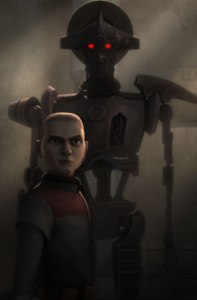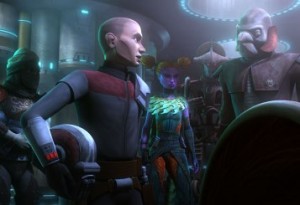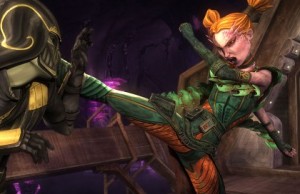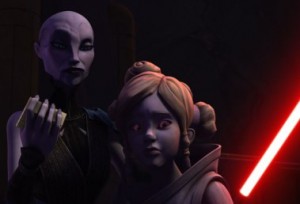Review by Megan Crouse
 Asajj Ventress has escaped death almost as many times as people around her have died. Last week’s “Massacre” of the Nightsisters was the second time Asajj has left a significant body count behind her. Despite being shuffled from one Master, Ky Narec, to another, Count Dooku, she is far from a child; she spent some time in control of an entire criminal organization on Rattatak and taught herself the two-lightsaber style, Jar’Kai. Ever since she joined Dooku she’s been hounding Anakin and Obi-Wan. Her biography is a list of narrow escapes punctuated by machinations and a flirty sort of elegance. Along the way she’s become one of the more complex characters in the Expanded Universe, in part because of her contrasting characteristics.
Asajj Ventress has escaped death almost as many times as people around her have died. Last week’s “Massacre” of the Nightsisters was the second time Asajj has left a significant body count behind her. Despite being shuffled from one Master, Ky Narec, to another, Count Dooku, she is far from a child; she spent some time in control of an entire criminal organization on Rattatak and taught herself the two-lightsaber style, Jar’Kai. Ever since she joined Dooku she’s been hounding Anakin and Obi-Wan. Her biography is a list of narrow escapes punctuated by machinations and a flirty sort of elegance. Along the way she’s become one of the more complex characters in the Expanded Universe, in part because of her contrasting characteristics.
Showing contrast is a great way to make viewers curious about a character, and it shows up a lot in Star Wars. Instead of all barbarian anger all the time, Darth Maul has a soft Coruscanti accent. Instead of being the pure white knight he dresses like, Obi-Wan is surprisingly skilled at impersonating bad guys and cutting off arms at bars. In the same way, Asajj Ventress is a mix of ferocious, adult skills and a childlike need for a place to call home. “Bounty” explores her reactions to recently fleeing the world that was very temporarily her refuge.
Exotic music accompanies the opening shots of Asajj entering her new hideout. Her costume is complex and asymmetrical. It shows off some leg while keeping the tabard and boots common to Star Wars aesthetic, which makes sense for the hot climate. I like the purple accents, and the whole costume has an air of being patched together. Ventress is trying to get lost in Tatooine’s small-time scum and villainy. She’s still got her Sith attitude, though. An alien chats her up with a line that is amusingly specific – “bald babe” – and it makes sense since he’s bald, too. Ventress makes like her rival Obi-Wan and stabs the guy, but does it a lot more subtly than Obi-Wan ever did. It was a cool bit of lightsaber wielding, and for a moment I thought the bar’s other occupants wouldn’t notice. But they do, and after an amusing reaction shot of some aliens, including a pigtailed Theelin, Ventress utters what may be my new least favorite Clone Wars line: “I’m not much of a talker,” promptly contradicting herself. I hope this was intended to show how she gets confused when she’s nervous, or how epic Sith banter just doesn’t quite work as well with lowlifes. Otherwise, it seemed to entirely remove the impression that would have been made if Ventress had just not spoken.
I loved the design of the Theelin. Her purple skin, orange hair, and green shirt were bright and childlike. The conversation between her, Ventress, and Bossk is full of so much hissing and elongated syllables that it’s tense based on attitude alone, which was probably the point. Bossk’s “merry band” sounds oddly flowery in comparison. One doglike creature later we get to Dengar, and his accent matches his relaxed posture perfectly.
As a brief aside, I want to mention that there has been some controversy in the fan circles about the casting of Dengar. Apparently Star Trek actor Simon Pegg hates the prequels. I see no problem with casting him if he and the casting director agreed for him to join the show. If he has talent, use it, and show a message of forgiveness along the way. There are a lot of Star Wars fans out there who would be happy to be part of their favorite saga even though they dislike parts of its story.
What’s more important is how Pegg’s acting matches with the established personality of the character. I was introduced to Dengar way back in the unexciting novel The Mandalorian Armor, and the nature of his story means that there’s not a lot of similarity between Dengar at fifty years old and Dengar at thirty. He’s a lot skinnier in The Clone Wars, and less cybernetic. But the one thing that stays the same is an unconcern with appearance that can come off as slovenliness, and Pegg’s drawling voice works to make the character sound both relaxed and unrefined.
 He’s just one of an ensemble here, including Boba and Bossk again. The bounty-hunters-not-getting-along theme was covered in the Rako Hardeen arc as well as back in Season Two with Sugi and company. I’m not a huge fan; a bunch of unlikeable people fulfilling a mission unrelated to the main three heroes’ plot just doesn’t hold my attention. Having Ventress as the point of view character makes this one slightly more interesting, though. Maybe she and Obi-Wan could discuss what it’s like for a Force user to hide out in the mundane underworld.
He’s just one of an ensemble here, including Boba and Bossk again. The bounty-hunters-not-getting-along theme was covered in the Rako Hardeen arc as well as back in Season Two with Sugi and company. I’m not a huge fan; a bunch of unlikeable people fulfilling a mission unrelated to the main three heroes’ plot just doesn’t hold my attention. Having Ventress as the point of view character makes this one slightly more interesting, though. Maybe she and Obi-Wan could discuss what it’s like for a Force user to hide out in the mundane underworld.
Speaking of missions and voice actors, a recognizable Tom Kane (who also voices the narrator) plays an alien, Major Rigosso, with a very unique mouth structure. The Belugans are a nice mix of alien and animal features: birdlike beaks, fat cheeks with fishlike gills or blubber structures, humanoid teeth, and a split jaw similar to the Elite species in Halo. Dave Filoni mentioned in an interview for the ForceCast a few months ago that he would have liked the Karkodon species to be a bit less shark-like, and the Belugans look like they might have been a design he preferred. (But still, they’re called Belugans, and their planet is given the Scrabble-winning name of Quarzite.)
Rigosso is the introduction to a dense mythology that drives the mission. The dialogue takes pains to explain that there’s a scientific reason for the planet only being accessible by elevator and hover train, and that somebody’s stolen the Belugan boss’s cargo. It isn’t so much a bounty hunt as a protection job. The item is being pursued by Kage Warriors, who sound like they’ve stepped out of a Japanese movie and have the same cool visual flair as the Theelin. One of the most creative uses of the ”camera” I’ve ever seen in The Clone Wars is an establishing shot of the whole hollow center of the train, with the bounty hunters going about their business inside and a nifty voiceover providing some narrative tension that also makes sense in the fictional environment.
Ventress’s angst emerges as an angry laziness at the rear of the train. “Whatever it is [in the box] better be worth all this effort.” There’s no proof that she’s thinking about the Nightsisters as she stares out into the distance, but I’d like to think that was the idea.
Last week we got zombies and this week it’s ninjas. The Kage Warriors are just plain cool, with their uniform black suits, unarmed combat, and insectile mounts. Personal preference for ninjas aside, they don’t feel organic to the Star Wars universe, but they feel unusual in the same way as the Force Wielders from last season’s Mortis episodes. Instead of trying to replicate the grungy, relatively simple Original Trilogy aesthetic, The Clone Wars is proving that the Star Wars universe is a place of infinite variation. A lot of the clothing from the Original Trilogy was Japanese-inspired anyway, though, so maybe the ninjas do feel a bit more right in the galaxy far, far away than the zombies or the Force Wielders.
The attack by the Kage Warriors is a fun fight with good use of multiple characters. The Theelin has a great moment when she has obvious trouble kicking a ninja into submission, but gets it eventually and then whips out a leaf-shaped boa weapon that she didn’t have the chance to use before. I have to give props to a small female character proving that she can succeed while acknowledging that it’s also going to feel difficult.
This may rank as one of my favorite fights in The Clone Wars. I also like that Dengar is such an average guy: he falls off the hover train and the plot rides a giant bug right past him. He had that everyman feel in other EU media, too. The sad music adds an interesting element, and the Theelin’s “Oh, hey boss” is a great bit of ancillary dialogue.
The action uses multiple characters and multiple lightsabers very well. Just when I thought the ninjas were all going to be faceless mooks, the Theelin and the poetically named droid C-21 Highsinger take on their leader, who shows Asajj how silent is done and kills Rigosso without a word, despite the banter-bait of “Over my dead body” beforehand.
 The Theelin’s fighting style is interesting: especially in her one-on-one fight with the ninja leader it seems that she’s got more lower body strength and skill with her legs than with her arms. She uses the boa to make up for that, but the ninja recognizes the disadvantage and uses the boa to send both the Theelin and the droid the way of Dengar. I like that this episode’s combat choreographers gave each character a certain strategy and strength.
The Theelin’s fighting style is interesting: especially in her one-on-one fight with the ninja leader it seems that she’s got more lower body strength and skill with her legs than with her arms. She uses the boa to make up for that, but the ninja recognizes the disadvantage and uses the boa to send both the Theelin and the droid the way of Dengar. I like that this episode’s combat choreographers gave each character a certain strategy and strength.
Boba Fett, who of course has already been established as pretty good with both hands and feet, gets into a scrap with the ninja and knocks over a box. Out tumbles… the MacGuffin? It’s a red-haired girl, Pluma Sodi, and I am immediately reminded of the first episode of Firefly, which featured human smuggling. Boba’s “Don’t worry, I’ll protect you” could be the practical words of a killer trying to keep his cargo intact, but it doesn’t look like it. Then, in true Princess Leia style, she slaps him.
Lots of things are explained quickly as the ninja leader reveals a dark blue-skinned face and brotherly concern. Apparently the Belugans were kidnapping his sister. The leader of the Kage Warriors, Krismo Sodi, adds to this episode’s list of contrasting colors. His dark skin and yellow eyes are definitely distinct, and about as subtle as the Theelin’s palatte or the purple armwarmers Asajj is wearing. That’s cool, though – there are many new designs in this episode, and a lot of them make me want to see more of the characters.
With Krismo concerned, Pluma scared, and Boba out of the picture for the moment, it’s up to Asajj to hold to her morals and be the bad guy in this situation that just got grayer. She has fun doing it, in her melancholic sort of way. It was exciting to see a Force user be able to defeat the ninja so easily; he was cool, but she’s cooler. I couldn’t help but get the sense that this episode, ostensibly about Asajj trying to find a home, shows that no matter her location she’s most at home being evil and good at it.
Some slightly muddled dialogue between Boba and Ventress tells us that both bounty hunters want the Sodi siblings tied up, but it’s a little more personal for Boba. He’s still mad about that “crazy” slap.
 Pluma Sodi’s dialogue isn’t exactly subtle, but it does bring us to the heart of the matter: Ventress’ search for a family. She remains stoic, but looks hurt. Either she takes her anger out on Boba or she just really needs more money for purple arm warmers, because she Force-chokes him and takes all of the bounty money for herself. It turns out that the Belugan wants Pluma for his bride, which is incredibly creepy based on her age and his species alone… and Asajj agrees. She’s traded Pluma for an unhappy Boba, and we see that Asajj is capable of feeling mercy, especially if she identifies with her captive.
Pluma Sodi’s dialogue isn’t exactly subtle, but it does bring us to the heart of the matter: Ventress’ search for a family. She remains stoic, but looks hurt. Either she takes her anger out on Boba or she just really needs more money for purple arm warmers, because she Force-chokes him and takes all of the bounty money for herself. It turns out that the Belugan wants Pluma for his bride, which is incredibly creepy based on her age and his species alone… and Asajj agrees. She’s traded Pluma for an unhappy Boba, and we see that Asajj is capable of feeling mercy, especially if she identifies with her captive.
This episode was very good. It combines a flashy fight scene with character progression and a little bit of humor. (Poor Boba.) It’s rare that The Clone Wars uses a plot to further a character’s inner conflict this effectively.
It’s not perfect: Asajj’s last lines as she walks away from the bounty hunters are, “Once I was just like you, but I’m not that person anymore. Now, I have a future.” She looks happier than she has all season, and I’m not sure if it’s because she learned about family or because she’s got money now. The pan up to the stars seems to indicate a feeling of freedom. The episode ties together potential discussions of all the sorts of family there are in the Star Wars world: the Jedi, the Sith, and the Dathomiri clans, as well as blood bonds like those of the Sodis. Katie Lucas again brings us one of the better episodes of the series. I give “Bounty” 8/10.
Megan Crouse is a recent college graduate with a strong interest in fandom studies and pop media. She writes This Blog Is Full of Words and has published poetry and short fiction. Other interests include martial arts, poultry, and Darth Maul.
